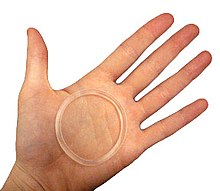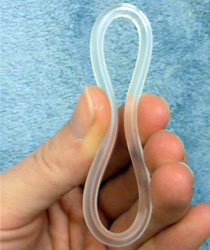Contraceptive ring
The contraceptive ring, also known as the vaginal ring or monthly ring , is a contraceptive that uses hormones to prevent ovulation . The plastic ring is inserted into the vagina and removed after three weeks. For the next seven days without a ring, menstruation-like bleeding begins . Two vaginal rings approved in Germany are currently available, the NuvaRing from MSD and Circlet from Pfizer . Both contain etonogestrel and ethinylestradiol .
effect
The hormones continuously released by the ring belong to the estrogens and gestagens , as with the birth control pill . They are absorbed locally by the vaginal lining . With a Pearl Index of 0.25 to 1.18, the vaginal ring is almost as safe as the pill. It requires a prescription in Germany, Switzerland and Austria .
Through the delivery of estrogens and progestins is ovulating prevented. About 15 micrograms of the estrogen ethinylestradiol and 120 micrograms of the luteal hormone etonogestrel are released daily. The progestin prevents the cervical mucus from liquefying and the penetration of the sperm is made more difficult. The lining of the uterus is changed in such a way that a fertilized egg cell cannot implant itself in it. The effect of the vaginal ring corresponds to the effect of the pill on a hormonal level.
application
The contraceptive ring is always inserted on the same day of the week and at the same time and removed at the same time after 21 days. It is inserted into the vagina like a tampon . After the 21 days, there is a 7-day break until the next application with a new ring. The sudden absence of hormones during the break leads to a menstrual-like hormone withdrawal bleeding, also known as a withdrawal bleeding. Prevention of pregnancy is guaranteed for the entire four weeks. The ring can be removed from the vagina for a maximum of three hours within 24 hours without reducing its effectiveness, for example if it interferes with sexual intercourse .
The vaginal rings are stored in the refrigerator in the pharmacy. After dispensing, they can be stored at room temperature for up to four months.
advantages
The ring is suitable for women who cannot or do not want to ensure regular intake of the “pill”, or for women for whom the “pill” is not fully guaranteed due to illnesses in the gastrointestinal area.
It is as safe as the “pill”, but has a lower risk of daily intake errors. It cannot be forgotten that often or taken too late. Vomiting and diarrhea do not affect the effect, but the same loss of effectiveness occurs through metabolism-stimulating drugs ( antibiotics ) as with the "pill". The hormone level in the blood is lower and more even than with the contraceptive patch or the “pill” (ethinylestradiol level approx. 20 pg / ml (NuvaRing) vs. approx. 70 pg / ml (patch) and 20–150 pg / ml (Marvelon)). As with other hormonal contraceptive methods, the withdrawal bleeding is often weaker or shorter and problems such as PMS , cramps and nausea during the bleeding are less than without hormonal contraceptives. In addition, up to three rings can be used one after the other without a break and therefore without your period and menstrual cramps.
Most women hardly feel the vaginal ring at all. However, the vaginal ring can be felt by some women and men during intercourse. It is easy to implement after a short practice. The withdrawal bleeding is stable and predictable.
disadvantage
As with all hormonal contraceptive methods, unwanted side effects can occur with the birth control ring. Often z. B. Headache , stomach ache , reluctance to have sex (decreased or impaired libido ), nausea , chest tension and hardening, water retention, weight gain, vaginal infections , mood swings, acne and painful menstrual periods. Spotting and intermenstrual bleeding can occur outside of the withdrawal bleeding. In a few cases the ring can be perceived as an unpleasant foreign body. During sexual intercourse it can be perceived as annoying by men and women, it can then be removed for up to three hours within 24 hours. The day of the week and the time of day should be observed with discipline when inserting and removing the ring. The tight fit of the ring must be checked regularly. Women with a wide vagina, for example shortly after giving birth, have an increased risk of losing the vaginal ring and thus also the contraceptive effect unnoticed. It must not be used during breastfeeding. The ring may need to be inserted before the end of your menstrual period. He can then fall into the toilet if the tampon is carelessly pulled out. In rare cases it can break. The ring is more expensive compared to the pill and condom. Like other hormonal contraceptives, it does not protect against sexually transmitted diseases. It must not be stored above 30 ° C and not below 2 ° C. The NuvaRing can be inserted up to 4 months from the time the cold chain is interrupted, i.e. when it is dispensed by the pharmacist. It does not matter whether it was stored in the refrigerator or at room temperature (not above 30 ° C).
Since this is a relatively new hormonal contraceptive method, there is not so much experience with the vaginal ring. It is therefore suspected that the possible side effects are the same as with the birth control pill, for example arterial and venous thrombosis and thromboembolism , an increased risk of cervical and breast cancer or pigment disorders . Smokers , diabetics , women with liver disease or blood clotting disorders, overweight and elderly women should carefully weigh the risks together with their specialist. When using it, interactions with other drugs should be considered.
A follow-up study from 2012 compared the frequency of venous thrombi between oral and non-oral contraceptive methods. It showed that women who used Nuvaring or a contraceptive patch had a significantly higher risk of thrombus than women who took regular oral contraceptives. One reason for this difference could be the different metabolism. While oral contraceptives are only ingested once a day and immediately metabolized by the liver, women who use patches or Nuvaring are exposed to a continuous dose of estrogen while switching off liver metabolism.
Individual evidence
- ↑ HJ Ahrendt, I. Nisand, C. Bastianelli et al .: Efficacy, acceptability and tolerability of the combined contraceptive ring, NuvaRing, compared with an oral contraceptive containing 30 microg of ethinyl estradiol and 3 mg of drospirenone. Contraception. 2006 Dec; 74 (6): 451-7. PMID 17157101
- ^ NN Sarkar: The combined contraceptive vaginal device (NuvaRing): a comprehensive review. Eur J Contracept Reprod Health Care. 2005 Jun; 10 (2): 73-8. PMID 16147810
- ↑ a b package insert "Instructions for use NuvaRing", as of June 2008, page 20, paragraph "Your ring was temporarily out of the vagina"
- ↑ NuvaRing ® technical information, as of March 2008.
- ↑ van den Heuvel MW, van Bragt AJ, Alnabawy AK, Kaptein MC: Comparison of ethinylestradiol pharmacokinetics in three hormonal contraceptive formulations: the vaginal ring, the transdermal patch and an oral contraceptive. Contraception. 2005 Sep; 72 (3): 168-174. PMID 16102549
- ↑ NuvaRing ® technical information, as of March 2008.
- ↑ Package insert NuvaRing, as of June 2008, section “5. How to store the NuvaRing "
- ↑ Package insert "Instructions for use NuvaRing", as of June 2008, pages 11 and 12, paragraph "Use of other drugs"
- ↑ Lidegaard, Øjvin; Øjvind Lidegaard, Lars Hougaard Nielsen, Charlotte Wessel Skovlund, and Ellen Løkkegaard (2012). "Venous thrombosis in users of non-oral hormonal contraception: follow-up study, Denmark 2001-10". BMJ 344: 1-9. doi : 10.1136 / bmj.e2990 . PMID 22577198 .
Web links
- Familienplanung.de - Hormonal methods, The vaginal ring : The information portal of the Federal Center for Health Education (BZgA)

